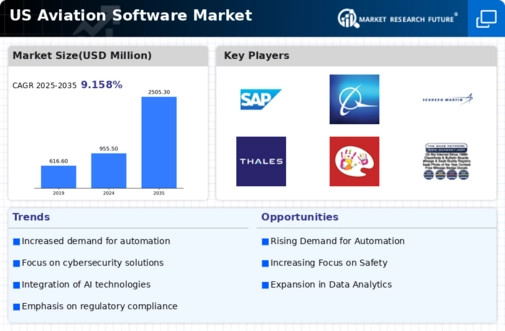Expansion of the Aviation Sector
The expansion of the aviation sector in the United States is a significant driver of growth in the aviation software market. With increasing passenger traffic and the rise of new airlines, there is a heightened demand for software solutions that can support operational scalability. The Federal Aviation Administration (FAA) projects a steady increase in air travel, which necessitates the adoption of advanced software to manage growing operational complexities. By 2025, the aviation software market is expected to benefit from this expansion, with an estimated growth rate of 8% annually. This trend indicates that as the aviation sector grows, so too will the need for innovative software solutions.
Growing Demand for Data Analytics
Data analytics is becoming increasingly vital in the aviation software market, as stakeholders seek to leverage data for informed decision-making. The ability to analyze vast amounts of operational data allows airlines to enhance their performance, reduce costs, and improve customer satisfaction. In 2025, the market for data analytics solutions within aviation software is expected to account for nearly 30% of the overall market share. This trend suggests that companies are prioritizing data-driven strategies to gain a competitive edge. As the aviation industry continues to evolve, the integration of data analytics into software solutions is likely to be a key driver of growth in the aviation software market.
Increased Focus on Operational Efficiency
Operational efficiency remains a critical focus for stakeholders in the aviation software market. Airlines and operators are continually seeking ways to streamline their operations, reduce turnaround times, and enhance overall productivity. The implementation of software solutions that facilitate real-time monitoring and management of resources is becoming essential. In 2025, it is anticipated that the demand for operational efficiency software will contribute significantly to the market's growth, potentially accounting for 25% of total revenues. This emphasis on efficiency not only helps in cost reduction but also improves service delivery, thereby driving the aviation software market forward.
Rising Importance of Safety Management Systems
Safety management systems (SMS) are gaining prominence in the aviation software market, as regulatory bodies and organizations emphasize the need for robust safety protocols. The integration of SMS into aviation software solutions enables operators to systematically manage safety risks and ensure compliance with industry standards. As safety regulations become more stringent, the demand for software that supports SMS is likely to increase. In 2025, it is projected that the SMS segment will represent approximately 20% of the aviation software market, highlighting the critical role of safety in driving software adoption and development.
Technological Advancements in Aviation Software
The aviation software market is experiencing a surge in technological advancements, which is driving innovation and efficiency. The integration of artificial intelligence (AI) and machine learning (ML) into aviation software solutions enhances operational capabilities, enabling predictive maintenance and optimized flight operations. As airlines and operators seek to improve their performance, the demand for sophisticated software solutions is likely to increase. In 2025, the market is projected to reach approximately $5 billion, reflecting a compound annual growth rate (CAGR) of around 10%. This growth indicates a strong inclination towards adopting advanced technologies in the aviation software market, as stakeholders recognize the potential for improved safety and operational efficiency.

















Leave a Comment